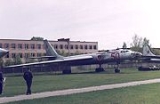
Tupolev Tu-16
Encyclopedia
The Tupolev
Tu-16 (NATO reporting name
: Badger) was a twin-engine jet bomber used by the Soviet Union
. It has flown for more than 50 years, and the Chinese license-built Xian H-6
remains in service with the Chinese air force
.
 In the late 1940s the Soviet Union
In the late 1940s the Soviet Union
was strongly committed to matching the United States
in strategic bombing
capability. The Soviets' only long-range bomber at the time was Tupolev's Tu-4 'Bull'
, a reverse-engineered
version of the American B-29 Superfortress
. The development of the extremely powerful Mikulin AM-3
turbojet led to the possibility of a large, jet-powered bomber.
The Tupolev design bureau began work on the Tu-88 ("Aircraft N") prototypes in 1950. The Tu-88 first flew on 27 April 1952. After winning a competition against the Ilyushin Il-46
, it was approved for production in December 1952. The first production bombers entered service with Frontal Aviation
in 1954, receiving the service designation Tu-16. It received the NATO reporting name
Badger-A.
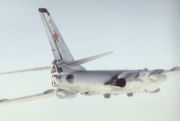 It had a new, large swept wing
It had a new, large swept wing
and two large Mikulin AM-3 turbojets, one in each wing root. It could carry a single massive FAB-9000 9,000-kg (19,800 lb) conventional bomb (the Russian equivalent of the British Grand Slam bomb
) or various nuclear weapon
s to a range of around 4,800 km (3,000 mi).
Although the Tu-16 began as a high-altitude, free-fall bomber, in the mid-1950s it was equipped to carry early Soviet cruise missile
s. The Tu-16KS-1 (Badger-B) version could carry AS-1 missiles over a combat radius of 1,800 km (1,125 mi). These very large weapons were aerodynamically similar to the Mikoyan-Gurevich MiG-15
fighter, fitted with either a nuclear or conventional warhead, had a range of about 140 km (90 mi). They were intended for use primarily against US Navy
aircraft carrier
s and other large surface ships. Subsequent Tu-16s were converted to carry later, more advanced missiles, while their designations changed several times.
 A versatile design, the Tu-16 was built in numerous specialized variants for reconnaissance
A versatile design, the Tu-16 was built in numerous specialized variants for reconnaissance
, maritime surveillance, electronic intelligence gathering (ELINT), and electronic warfare
(ECM
). A total of 1,507 aircraft was constructed in three plants in the Soviet Union, in 1954-1962. A civilian adaptation, the Tupolev Tu-104
, saw passenger service with Aeroflot
. The Tu-16 was also exported to Egypt
, Indonesia
, and Iraq
. It continued to be used by the Air Forces and naval aviation of the Soviet Union and subsequently Russia until 1993.
Delivery of the Tu-16 to China
began in 1958, and the Xi'an Aircraft Industrial Corporation
(XAC) produced a copy of it under the Chinese designation Xian H-6
. At least 120 of these aircraft remain in service. 14 May 1965, one of the PLAAF Tu-16 bombers carried out the first airborne nuclear weapon test inside China.


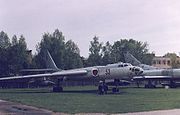
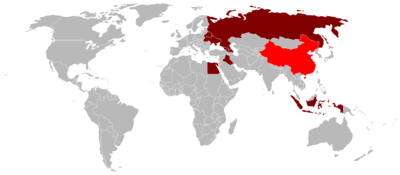
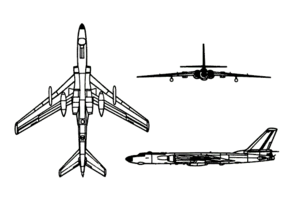
Tupolev
Tupolev is a Russian aerospace and defence company, headquartered in Basmanny District, Central Administrative Okrug, Moscow. Known officially as Public Stock Company Tupolev, it is the successor of the Tupolev OKB or Tupolev Design Bureau headed by the Soviet aerospace engineer A.N. Tupolev...
Tu-16 (NATO reporting name
NATO reporting name
NATO reporting names are classified code names for military equipment of the Eastern Bloc...
: Badger) was a twin-engine jet bomber used by the Soviet Union
Soviet Union
The Soviet Union , officially the Union of Soviet Socialist Republics , was a constitutionally socialist state that existed in Eurasia between 1922 and 1991....
. It has flown for more than 50 years, and the Chinese license-built Xian H-6
Xian H-6
The Xian H-6 is a license-built version of the Soviet Tupolev Tu-16 twin-engine jet bomber, built for the Chinese People's Liberation Army Air Force....
remains in service with the Chinese air force
People's Liberation Army Air Force
The People's Liberation Army Air Force is the aviation branch of the People's Liberation Army, the military of the People's Republic of China...
.
Development

Soviet Union
The Soviet Union , officially the Union of Soviet Socialist Republics , was a constitutionally socialist state that existed in Eurasia between 1922 and 1991....
was strongly committed to matching the United States
United States
The United States of America is a federal constitutional republic comprising fifty states and a federal district...
in strategic bombing
Strategic bombing
Strategic bombing is a military strategy used in a total war with the goal of defeating an enemy nation-state by destroying its economic ability and public will to wage war rather than destroying its land or naval forces...
capability. The Soviets' only long-range bomber at the time was Tupolev's Tu-4 'Bull'
Tupolev Tu-4
The Tupolev Tu-4 was a piston-engined Soviet strategic bomber that served the Soviet Air Force from the late 1940s to mid 1960s...
, a reverse-engineered
Reverse engineering
Reverse engineering is the process of discovering the technological principles of a device, object, or system through analysis of its structure, function, and operation...
version of the American B-29 Superfortress
B-29 Superfortress
The B-29 Superfortress is a four-engine propeller-driven heavy bomber designed by Boeing that was flown primarily by the United States Air Forces in late-World War II and through the Korean War. The B-29 was one of the largest aircraft to see service during World War II...
. The development of the extremely powerful Mikulin AM-3
Mikulin AM-3
|-See also:...
turbojet led to the possibility of a large, jet-powered bomber.
The Tupolev design bureau began work on the Tu-88 ("Aircraft N") prototypes in 1950. The Tu-88 first flew on 27 April 1952. After winning a competition against the Ilyushin Il-46
Ilyushin Il-46
|-See also:...
, it was approved for production in December 1952. The first production bombers entered service with Frontal Aviation
Soviet Air Force
The Soviet Air Force, officially known in Russian as Военно-воздушные силы or Voenno-Vozdushnye Sily and often abbreviated VVS was the official designation of one of the air forces of the Soviet Union. The other was the Soviet Air Defence Forces...
in 1954, receiving the service designation Tu-16. It received the NATO reporting name
NATO reporting name
NATO reporting names are classified code names for military equipment of the Eastern Bloc...
Badger-A.

Swept wing
A swept wing is a wing planform favored for high subsonic jet speeds first investigated by Germany during the Second World War. Since the introduction of the MiG-15 and North American F-86 which demonstrated a decisive superiority over the slower first generation of straight-wing jet fighters...
and two large Mikulin AM-3 turbojets, one in each wing root. It could carry a single massive FAB-9000 9,000-kg (19,800 lb) conventional bomb (the Russian equivalent of the British Grand Slam bomb
Grand Slam bomb
The Grand Slam was a 22,000 lb earthquake bomb used by RAF Bomber Command against strategic targets during the Second World War.Known officially as the Bomb, Medium Capacity, 22,000 lb, it was a scaled up version of the Tallboy bomb and closer to the original size that the bombs' inventor,...
) or various nuclear weapon
Nuclear weapon
A nuclear weapon is an explosive device that derives its destructive force from nuclear reactions, either fission or a combination of fission and fusion. Both reactions release vast quantities of energy from relatively small amounts of matter. The first fission bomb test released the same amount...
s to a range of around 4,800 km (3,000 mi).
Although the Tu-16 began as a high-altitude, free-fall bomber, in the mid-1950s it was equipped to carry early Soviet cruise missile
Cruise missile
A cruise missile is a guided missile that carries an explosive payload and is propelled, usually by a jet engine, towards a land-based or sea-based target. Cruise missiles are designed to deliver a large warhead over long distances with high accuracy...
s. The Tu-16KS-1 (Badger-B) version could carry AS-1 missiles over a combat radius of 1,800 km (1,125 mi). These very large weapons were aerodynamically similar to the Mikoyan-Gurevich MiG-15
Mikoyan-Gurevich MiG-15
The Mikoyan-Gurevich MiG-15 was a jet fighter developed for the USSR by Artem Mikoyan and Mikhail Gurevich. The MiG-15 was one of the first successful swept-wing jet fighters, and it achieved fame in the skies over Korea, where early in the war, it outclassed all straight-winged enemy fighters in...
fighter, fitted with either a nuclear or conventional warhead, had a range of about 140 km (90 mi). They were intended for use primarily against US Navy
United States Navy
The United States Navy is the naval warfare service branch of the United States Armed Forces and one of the seven uniformed services of the United States. The U.S. Navy is the largest in the world; its battle fleet tonnage is greater than that of the next 13 largest navies combined. The U.S...
aircraft carrier
Aircraft carrier
An aircraft carrier is a warship designed with a primary mission of deploying and recovering aircraft, acting as a seagoing airbase. Aircraft carriers thus allow a naval force to project air power worldwide without having to depend on local bases for staging aircraft operations...
s and other large surface ships. Subsequent Tu-16s were converted to carry later, more advanced missiles, while their designations changed several times.

Reconnaissance
Reconnaissance is the military term for exploring beyond the area occupied by friendly forces to gain information about enemy forces or features of the environment....
, maritime surveillance, electronic intelligence gathering (ELINT), and electronic warfare
Electronic warfare
Electronic warfare refers to any action involving the use of the electromagnetic spectrum or directed energy to control the spectrum, attack an enemy, or impede enemy assaults via the spectrum. The purpose of electronic warfare is to deny the opponent the advantage of, and ensure friendly...
(ECM
Electronic countermeasures
An electronic countermeasure is an electrical or electronic device designed to trick or deceive radar, sonar or other detection systems, like infrared or lasers. It may be used both offensively and defensively to deny targeting information to an enemy...
). A total of 1,507 aircraft was constructed in three plants in the Soviet Union, in 1954-1962. A civilian adaptation, the Tupolev Tu-104
Tupolev Tu-104
The Tupolev Tu-104 was a twin-engined medium-range turbojet-powered Soviet airliner and the world's first successful jet airliner...
, saw passenger service with Aeroflot
Aeroflot
OJSC AeroflotRussian Airlines , commonly known as Aeroflot , is the flag carrier and largest airline of the Russian Federation, based on passengers carried per year...
. The Tu-16 was also exported to Egypt
Egypt
Egypt , officially the Arab Republic of Egypt, Arabic: , is a country mainly in North Africa, with the Sinai Peninsula forming a land bridge in Southwest Asia. Egypt is thus a transcontinental country, and a major power in Africa, the Mediterranean Basin, the Middle East and the Muslim world...
, Indonesia
Indonesia
Indonesia , officially the Republic of Indonesia , is a country in Southeast Asia and Oceania. Indonesia is an archipelago comprising approximately 13,000 islands. It has 33 provinces with over 238 million people, and is the world's fourth most populous country. Indonesia is a republic, with an...
, and Iraq
Iraq
Iraq ; officially the Republic of Iraq is a country in Western Asia spanning most of the northwestern end of the Zagros mountain range, the eastern part of the Syrian Desert and the northern part of the Arabian Desert....
. It continued to be used by the Air Forces and naval aviation of the Soviet Union and subsequently Russia until 1993.
Delivery of the Tu-16 to China
People's Republic of China
China , officially the People's Republic of China , is the most populous country in the world, with over 1.3 billion citizens. Located in East Asia, the country covers approximately 9.6 million square kilometres...
began in 1958, and the Xi'an Aircraft Industrial Corporation
Xi'an Aircraft Industrial Corporation
Xi'an Aircraft Industrial Corporation , also known as Xi'an Aircraft Company Limited is a Chinese aircraft manufacturer and developer of large and medium-sized airplanes. It is based in Yanliang District, Xi'an, Shaanxi Province. It is joint partners with 603rd Aircraft Design Institute of...
(XAC) produced a copy of it under the Chinese designation Xian H-6
Xian H-6
The Xian H-6 is a license-built version of the Soviet Tupolev Tu-16 twin-engine jet bomber, built for the Chinese People's Liberation Army Air Force....
. At least 120 of these aircraft remain in service. 14 May 1965, one of the PLAAF Tu-16 bombers carried out the first airborne nuclear weapon test inside China.
Variants
Among the main production variants of the Badger were the Tu-16 and Tu-16A bombers; Tu-16KS and Tu-16K-10 missile carriers; Tu-16SPS, "Elka", and Tu-16Ye ECM aircraft; Tu-16R reconnaissance aircraft; and Tu-16T torpedo bomber; others were produced from conversions. Individual aircraft could be modified several times, with designations changed, especially concerning missile-carrying aircraft.- Badger A (Tu-16) - This the basic configuration of the Tu-16 bomberBomberA bomber is a military aircraft designed to attack ground and sea targets, by dropping bombs on them, or – in recent years – by launching cruise missiles at them.-Classifications of bombers:...
deployed in 1954 to replace the Tu-4. Several modified models of these variant existed, all of which were known as Badger A in the West.- Tu-16A - Modified Tu-16s designed to carry nuclear bombs, one of main versions, with 453 built. Many of those units were subsequently converted into other variants.
- Tu-16Z - An early specialized version of the Tu-16 that served as airborne tankers (a refuelling method: wing-to-wing), though they retain their medium bomber role.
- Tu-16G (Tu-104G) - Fast air mail model, Aeroflot aircrew training version.
- Tu-16N - A dedicated tanker version for Tu-22/Tu-22M bombers, with probe and drogue system. Entered service in 1963. Similar aircraft Tu-16NN converted from Tu-16Z.
- Tu-16T - Limited production maritime strike version (torpedo bomber), that served in the Soviet Naval AviationSoviet Naval AviationSoviet Naval Aviation was a part of the Soviet Navy.- Origins :...
, and carried torpedoTorpedoThe modern torpedo is a self-propelled missile weapon with an explosive warhead, launched above or below the water surface, propelled underwater towards a target, and designed to detonate either on contact with it or in proximity to it.The term torpedo was originally employed for...
es, minesNaval mineA naval mine is a self-contained explosive device placed in water to destroy surface ships or submarines. Unlike depth charges, mines are deposited and left to wait until they are triggered by the approach of, or contact with, an enemy vessel...
and depth charges. 76 built and some more converted. All units subsequently converted into Tu-16S configuration. - Tu-16S - A lifeboat carrier version used for search and rescue operations.
- Tu-16Ye - These were equipped with heavy electronic warfareElectronic warfareElectronic warfare refers to any action involving the use of the electromagnetic spectrum or directed energy to control the spectrum, attack an enemy, or impede enemy assaults via the spectrum. The purpose of electronic warfare is to deny the opponent the advantage of, and ensure friendly...
and electronic intelligence (ELINT) equipment.
- Badger B (Tu-16KS) - Variant designed as a launch platform for two AS-1 Kennel/KS-1 Komet missiles. 107 built in 1954-1958, served with the Soviet Naval AviationSoviet Naval AviationSoviet Naval Aviation was a part of the Soviet Navy.- Origins :...
, Egypt and Indonesia. Soviet ones later converted with newer missiles.

- Badger C (Tu-16K-10) - Another Naval Aviation variant, units of this version carried a single AS-2 Kipper/K-10S anti-ship missileAnti-ship missileAnti-ship missiles are guided missiles that are designed for use against ships and large boats. Most anti-ship missiles are of the sea-skimming type, many use a combination of inertial guidance and radar homing...
. 216 built in 1958-1963. It differed from other variants having a radar in a nose. A further development, the Tu-16K-10-26, carried a single K-10S and two KSR-2 or KSR-5 AS-6 Kingfish missiles (K-26 missile complex). Some were later converted into ELINT platforms. - Badger D (Tu-16RM-1) - Maritime reconnaissance model with ELINT equipment; 23 converted from Tu-16K-10. It retained its radar in a nose and could guide K-10S missiles, fired from other planes, at targets.
- Badger E (Tu-16R) - ReconnaissanceReconnaissanceReconnaissance is the military term for exploring beyond the area occupied by friendly forces to gain information about enemy forces or features of the environment....
version of the airframe, with ELINT equipment, first of all meant for maritime reconnaissance. It could guide KS missiles.- Tu-16RM-2 - modified Tu-16R, serving in the Naval Aviation. It could guide KSR-2 missiles.
- Tu-16KRM - Launch platforms for target dronesUnmanned aerial vehicleAn unmanned aerial vehicle , also known as a unmanned aircraft system , remotely piloted aircraft or unmanned aircraft, is a machine which functions either by the remote control of a navigator or pilot or autonomously, that is, as a self-directing entity...
(a variant of Tu-16K-26).
- Badger F (Tu-16RM-2) - Another reconnaissance version based on the -16R/RM but with the addition of external ELINT equipment.

- Badger G (Tu-16K/Tu-16KSR) - Serving in the Naval Aviation, these were conversions from earlier models. These were designed to carry bombs in internal bays in addition to carrying air-to-surface missiles externally, such as the AS-5 Kelt and AS-6 Kingfish. There existed numerous variants, designated either from carried missile complex (K-11, K-16 and K-26) or from missiles of these complexes (KSR-11, KSR-2 and KSR-5). Following further modifications, they were also given suffixes. Main variants:
- Tu-16KSR-2 - carrying the K-16 complex (two KSR-2 missiles). Used from 1962. Similar aircraft, converted from other variants, were designated Tu-16K-16.
- Tu-16K-11-16 - carrying the K-16 complex (KSR-2 missiles) or the K-11 complex (two anti-radar KSR-11 missiles). Used from 1962. Similar aircraft were designated Tu-16KSR-2-11. Over 440 Tu-16 could carry the K-16 or K-11 complex.

-
- Tu-16K-26 - carrying the K-26 complex (two KSR-5 missiles), retaining a capability of KSR-2 and 11 missiles. Used from 1969. Similar aircraft were designated Tu-16KSR-2-5-11 or Tu-16KSR-2-5 (no KSR-11 capability). Over 240 Tu-16 could carry the K-26 complex.
- Tu-16K-26P - carrying the K-26P missiles (two anti-radar KSR-5P missiles, as well as KSR-5, 2 or 11).
- Badger H (Tu-16 Elka) - Designed for stand-off electronic warfareElectronic warfareElectronic warfare refers to any action involving the use of the electromagnetic spectrum or directed energy to control the spectrum, attack an enemy, or impede enemy assaults via the spectrum. The purpose of electronic warfare is to deny the opponent the advantage of, and ensure friendly...
and electronic counter-measures support. - Badger J (Tu-16P Buket) - Another electronic warfare variant configured as an ECM strike escort.
- Badger K (Tu-16Ye) - Believed to be a version of the Badger F configuration possessing enhanced ELINT capability.
- Badger L (Tu-16P) - Another version of the Badger J with more modern systems and used in ELINT role.
Operators

- Armenian Air ForceArmenian Air ForceThe Armenian Air Force is a small air arm formed by independent Armenia in 1992 in the wake of the dissolution of the Soviet Union. It is organized and equipped principally to provide Armenian ground forces with tactical air support in the form of ground attack and airlift in mountainous terrain...
: 30 aircraft inherited from the Soviet Union. Out of service by 1995.
- Azerbaijan Air ForceAzerbaijan Air ForceThe Azerbaijani Air and Air Defence Force often referred to as the Azerbaijani Air Force is the air force and air defence force of the Azerbaijani Armed Forces....
: 10 aircraft inherited from the Soviet Union. Out of service by 1995.
- Belarus Air Force : 121 aircraft inherited upon the fall of the Soviet Union, out of service by 1995.
- People's Liberation Army Air ForcePeople's Liberation Army Air ForceThe People's Liberation Army Air Force is the aviation branch of the People's Liberation Army, the military of the People's Republic of China...
: A few Tu-16s were acquired in 1959; the type was then built under license as the Xian H-6Xian H-6The Xian H-6 is a license-built version of the Soviet Tupolev Tu-16 twin-engine jet bomber, built for the Chinese People's Liberation Army Air Force.... - People's Liberation Army Navy Air Force
- Egyptian Air ForceEgyptian Air ForceThe Egyptian Air Force, or EAF , is the aviation branch of the Egyptian Armed Forces. The EAF is headed by an Air Marshal . Currently, the commander of the Egyptian Air Force is Air Marshal Reda Mahmoud Hafez Mohamed...
: Operated Tu-16KS, Tu-16T, Tu-16KSR-2-11, and Tu-16R. Also operated H-6. Last retired in 2000.
- Georgian Air ForceGeorgian Air ForceThe Georgian Air Force is the air arm of the Georgian Armed Forces. Currently, it has 2,971 military and civilian personnel, fixed wing aircraft , helicopters of different types and air defense missiles of the "surface-to-air" class. The Air Force was founded in 1991 in the wake of the break-up...
: 20 aircraft inherited from the Soviet Union. Out of service by 1995.
- Indonesian Air ForceIndonesian Air ForceThe Indonesian Air Force is the air force branch of the Indonesian National Armed Forces.The Indonesian Air Force has 34,930 personnel equipped with 110 combat aircraft including Su-27 and Su-30.-Before Indonesian independence :...
: 26 Tu-16KS-1 acquired in 1961. Used during the preparation of Operation Trikora in 1962, the taking of Western New GuineaWestern New GuineaWest Papua informally refers to the Indonesian western half of the island of New Guinea and other smaller islands to its west. The region is officially administered as two provinces: Papua and West Papua. The eastern half of New Guinea is Papua New Guinea.The population of approximately 3 million...
from the Netherlands (now Papua and Papua Barat). They were also planned for attacking the Colossus class aircraft carrierColossus class aircraft carrierThe 1942 Design Light Fleet Carrier, commonly referred to as the British Light Fleet Carrier, was a light aircraft carrier design created by the Royal Navy during World War II, and used by eight naval forces between 1944 and 2001...
, HNLMS Karel DoormanHNLMS Karel Doorman (R81)HNLMS Karel Doorman was a Colossus-class aircraft carrier of the Royal Netherlands Navy. The ship was the British HMS Venerable before she was sold in 1948 to the Netherlands as a light attack carrier. In 1960 she was involved in the decolonization conflict in Western New Guinea with Indonesia...
. All were based at Iswahjudi Air Base, Madiun, East Java, and were grounded in 1969. No longer in service since 1970.
- Iraqi Air ForceIraqi Air ForceThe Iraqi Air Force or IQAF is the military branch in Iraq responsible for the policing of international borders, surveillance of national assets and aerial operations...
: Eight Tu-16, six Tu-16KSR-2-11. Also operated 4 B-6D (H-6D). All but one B-6D destroyed in Operation Desert Storm in 1991. The remaining B-6D was destroyed in 2003.
- Russian Air ForceRussian Air ForceThe Russian Air Force is the air force of Russian Military. It is currently under the command of Colonel General Aleksandr Zelin. The Russian Navy has its own air arm, the Russian Naval Aviation, which is the former Soviet Aviatsiya Voyenno Morskogo Flota , or AV-MF).The Air Force was formed from...
: Many aircraft inherited from the Soviet Union. Out of service by 1993. - Russian Naval AviationRussian Naval AviationThe Russian Naval Aviation , is the air arm of the Russian Navy...
- Soviet Air ForceSoviet Air ForceThe Soviet Air Force, officially known in Russian as Военно-воздушные силы or Voenno-Vozdushnye Sily and often abbreviated VVS was the official designation of one of the air forces of the Soviet Union. The other was the Soviet Air Defence Forces...
- Soviet Naval AviationSoviet Naval AviationSoviet Naval Aviation was a part of the Soviet Navy.- Origins :...
- Ukrainian Air ForceUkrainian Air ForceThe Ukrainian Air Force is a part of the Armed Forces of Ukraine. Ukrainian Air Force Command and headquarters are located in the city of Vinnytsia....
: 18 aircraft inherited from USSR. All retired from service.
Specifications (Tu-16)

See also
External links
- Global Security.org
- FAS on the Tu-16
- Xian H-6 Badger
- H-6 Medium Bomber
- http://airwar.ru/ - Ugolok Neba (Russian language)
- H-6H and H-6K Cruise Missile Bomber, AirForceWorld.com

